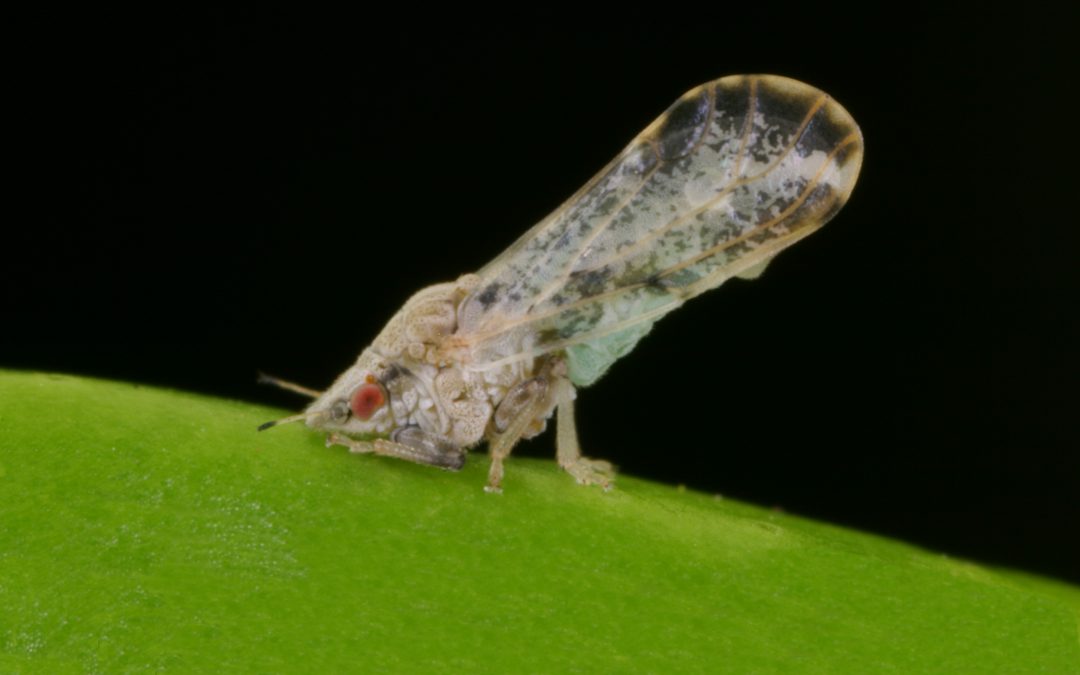
by Mark Tancig | Jan 13, 2022
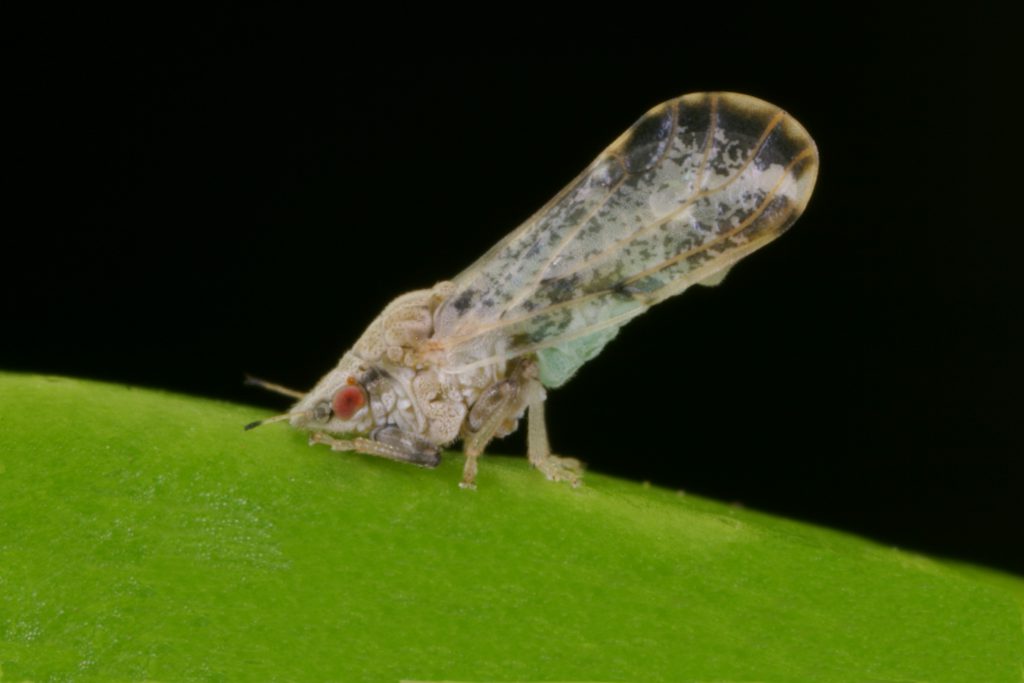
Asian citrus psyllid, Diaphorina citri. UF/IFAS/Entomology Photo: Michael Rogers.
In late 2016, as many of us were enjoying the harvests from our backyard citrus, a bacterial plant disease that can affect all citrus, citrus greening, was widespread in central and south Florida but had not made it this far north. That year, the vector, the insect that spreads the disease from tree to tree, had been found in Leon County and a few other surrounding Panhandle counties, but the disease had not. By mid-2017, the disease had been confirmed in Franklin County and we hoped that our cooler temperatures could keep the insect and disease at bay. Well, I regret to inform you that the disease has also now been confirmed in Leon County, growing in a residential yard in Tallahassee. Now that it is confirmed in non-coastal (and cooler) north Florida locations, I thought a review of the signs and symptoms – as well as what to do with your tree if you suspect or confirm greening – would be helpful.
The tricky part about diagnosing citrus greening is that it has symptoms that look very similar to soil nutrient deficiency symptoms, especially when first infected. This is a good time to mention that citrus require certain micro-nutrients for optimal growth and a citrus-specific fertilizer product should be used when applying fertilizer. Both the disease and certain nutrient deficiencies cause yellowing of the leaves. With greening, the yellowing is typically blotchy and/or not in any particular pattern. Nutrient deficiencies typically cause unique patterns of yellowing, such as a V-shape or artistic-like symmetrical patterns on each side of the leaf’s midvein. The soil’s acidity, or pH, can also cause some nutrients to not be taken up by the plant even if they are present. Soil testing, available from your local UF/IFAS Extension office, and scheduled fertilizations with a citrus-specific fertilizer can ensure that nutrients are not to blame for the discoloring of leaves. More advanced stages of the disease cause such symptoms as leaf drop, fruit drop, lop-sided fruit, uneven inner fruit cores, and reduced fruit quality.

Citrus greening symptoms of the fruit. Photo by Brooke Moffis.
A more obvious sign of potential problems for your citrus are the presence of the insect vector, the Asian citrus psyllid. This is a tiny little insect that goes from one leaf to the other sucking up plant saps for food and unknowingly spreading the bacterium responsible for citrus greening. You can monitor for them by looking closely at the new flushes of growth. If the psyllids are present, you will likely notice most their small, peach-colored eggs and/or white, waxy secretions. If found, it doesn’t necessarily mean that your tree has greening, but you will want to minimize the chance that they could carry it to your tree. The psyllids can be treated with pesticides, ranging from the less harsh options (horticulture oils, neem oil, kaolin clay) to the more hardcore stuff (malathion, carbaryl, imidacloprid). Of course, always read the label of any pesticide before use and/or consult a qualified landscape professional for assistance.
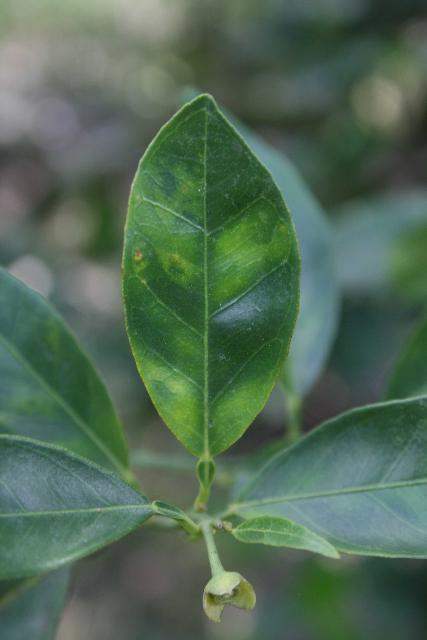
Blotchy leaf symptom of citrus greening. Photo by Jamie D. Burrow.
If you suspect your tree is infected, a diagnostic test can be performed by UF/IFAS plant pathologists at the North Florida Research and Education Center (NFREC) in Quincy to confirm. The test does cost $50, which may seem a little steep, but it’s an expensive lab analysis to run and may be worth piece of mind.
If citrus greening is confirmed in your tree, the right thing to do, unfortunately, is to remove and burn the plant material as there is no known cure. While the Florida Department of Agriculture and Consumer Services (FDACS) doesn’t have any removal requirements for infected dooryard citrus, tree removal is best to prevent additional spread of the disease to other trees, especially those grown by commercial producers in our area. This may seem drastic but eventually the health of the tree and quality of the fruit will decline to a point where you will want to remove it anyway. Don’t forget that movement of any citrus plant outside of the state is prohibited for the very reason of preventing spread of citrus diseases.
You may be asking, “Is it okay to replace it with another citrus tree?” The answer is yes you can, but you do risk re-infection and will want to be monitoring the new planting.
You may also be thinking, “What is going to happen to Florida citrus?” That’s a question that many researchers at UF/IFAS are trying to answer. There is some hope that intense irrigation and nutrient management, as well as specific pruning practices, can help infected trees continue to be profitable for commercial growers. Recently, UF/IFAS researchers were awarded several grants to try and figure a way out of this problem. Some of the lines of research focus on exploring the resistance found in different citrus varieties, including an Australian lime that appears to be greening resistant. This could potentially be used as a future rootstock. Another approach is to try and treat the plants with a particular peptide that would prevent the disease from binding in the insect’s gut. Isn’t that amazing?
Until a fix is found, we should be monitoring for this disease in our area and taking steps to reduce its presence through controlling the psyllids and removing infected trees. If you suspect a tree has greening, please contact your local county Extension office to review the symptoms and discuss your options.
Much more information on citrus greening is available at the following Ask IFAS website: https://edis.ifas.ufl.edu/entity/topic/citrus_greening and from this 2017 article – https://nwdistrict.ifas.ufl.edu/phag/2017/03/03/disease-alert-citrus-greening-and-asian-citrus-psyllids-found-in-the-panhandle/.

by Ray Bodrey | Jan 13, 2022
January and February are typically the coldest months in Florida. Low temperatures can damage even the more cold-hardy plants. However, there are measures that can be done to help cold-damaged plants recover.
After a frost or freeze, see if your plants are dry. Even injured plants need water. Plants can be greatly damaged if the temperature drops suddenly, as they have no time to acclimate to the freezing temperatures. These freezing temps cause ice crystals to form in plants cells. These crystals expand, rupturing the cell walls and preventing the plant from maintaining shape. If severe, this can certainly kill tender plants. On more cold hardy plants, damaged foliage will appear wilted and curled down. In a few hours or days, it will darken and turn black. Flowers, buds, and new growth often dieback under freezing temps.
After freezing temperatures occur, it’s important to remove damaged leaves and flowers as soon as they turn brown or black. This will help prevent diseases from occurring. Pruning should be postponed until cold temperatures are no longer expected and new growth begins to appear on the plant. This practice ensures live wood, which appears dead from losing its leaves, is not mistakenly removed from the plant. Cold damaged wood can be detected by examining the cambium layer (under the bark) of the plant. If it has black or brown discoloration, it is damaged and should be pruned back behind these points. Plants should be fertilized in the spring, to encourage new growth.
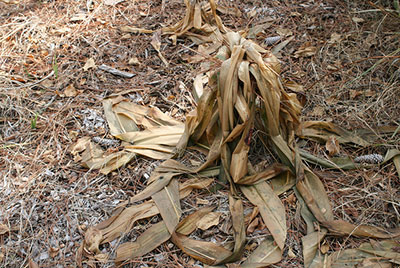
Cold damage. Photo Credit: University of Florida/IFAS
What about proactive care? You can accomplish this by moving potted plants indoors and covering tender landscape plants with a protective covering. Protective covering can include old bed sheet, pieces of material or fabric, and cardboard boxes. Be careful not to let the protective covering touch the plants. The surface of the covering will become as cold as the air temperatures and may damage any tender leaves it encounters. Also, don’t forget to remove the covering the next day when temperature raises this is important so the plants do not “bake” in the warmer temperatures. Plants placed near the house, lights, or other structures, which shelter them from wind, will be more protected than those fully exposed to the cold air.
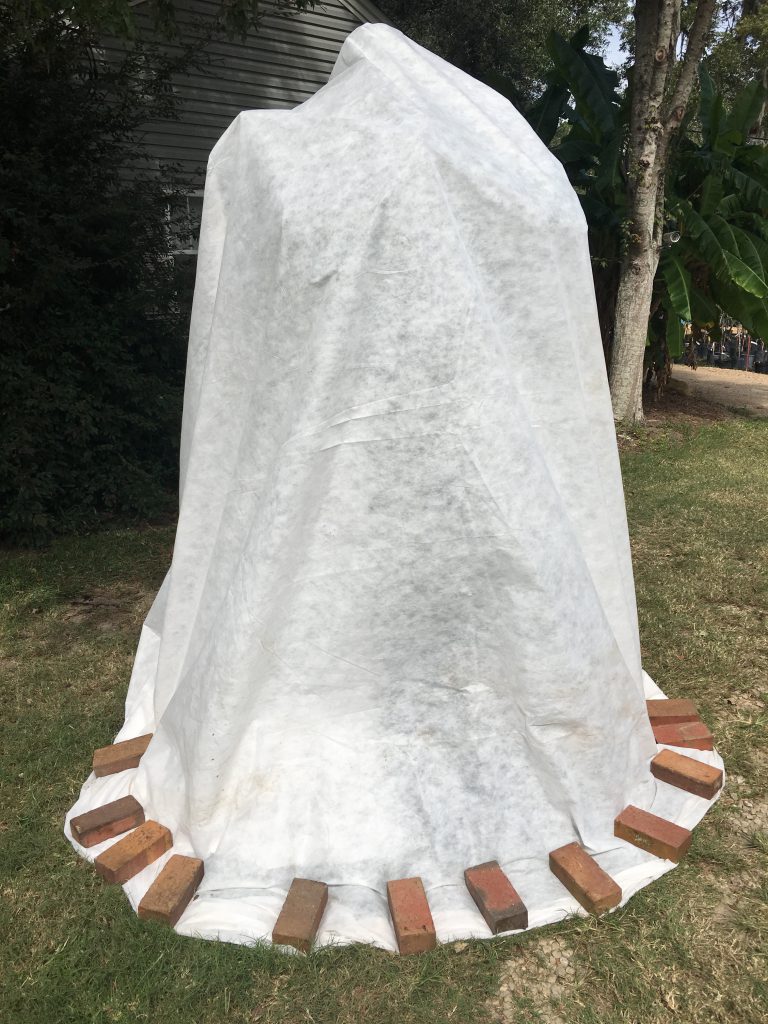
Use frost cloth to completely cover cold sensitive plants. Be sure to make complete contact with the ground and use heavy objects to keep the fabric secure. Photo by Jonathan Burns.
For more information on freeze damage plants contact your local county extension office.
Supporting information for this article can be found in the UF/IFAS Extension EDIS publication: “Cold Protection of Landscape Plants”, by Sydney Park Brown: https://edis.ifas.ufl.edu/publication/mg025
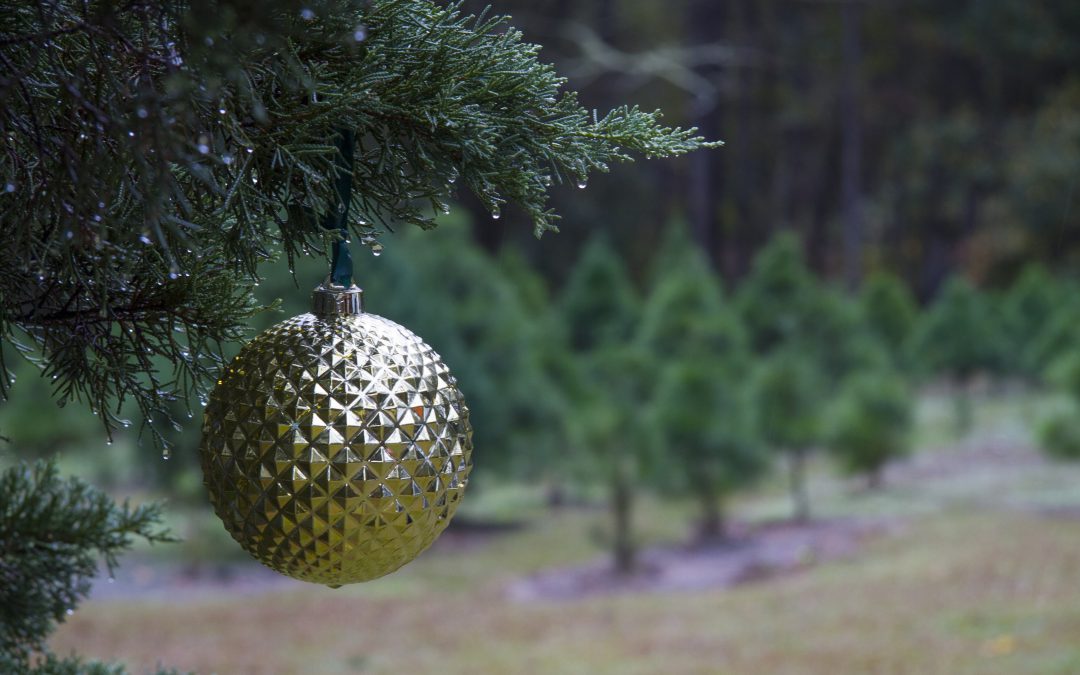
by Daniel J. Leonard | Dec 31, 2021
Christmas is among my favorite holidays. The religious significance, music, lights, amazing food, fellowship with family, and giving and receiving gifts all lend something special to the season. However, the tradition that arguably gets the most attention is selecting and putting up a Christmas tree! Those that participate in the festivities and put up a Christmas tree have three options: purchasing an artificial tree, purchasing a real tree, or growing your own.
While I like the convenience of a pre-lit tree as much as anyone, artificial trees don’t do a whole lot for the environment or sustainable US agriculture. They are almost exclusively produced overseas and contain non-biodegradable plastics. Not the best. If you select option two and choose to purchase a real tree, you’ll help support a sustainable US agriculture industry! According to the National Christmas Tree Association, there are ~25-30 million Christmas trees sold annually in the US and 350 million more currently growing on Christmas tree farms waiting their turn! Purchasing real Christmas trees also ensures that the over 100,000 Christmas tree farm workers remain employed, and the 1/3 million acres US Christmas tree farms comprise will remain non-developed “green spaces”!
But for the green-thumbed Christmas enthusiast that’s willing to put in a little time and effort, there is a third choice – growing your very own Christmas tree right at home! In the Panhandle, there are several species, Florida natives and not, that make wonderful Christmas trees and are easy to grow!
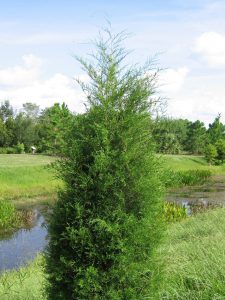
Red Cedar makes a fine Florida Christmas tree!
Red Cedar (Juniperus virginiana) – This Florida native is the classic southern evergreen. Growing quickly to the desired heights of 4’-10’, emitting a “Christmas tree smell”, and possessing dark, dense foliage, Red Cedar makes an excellent Christmas tree! Red Cedar performs very well in most soils but does not like wet feet and will not tolerate continuously saturated areas.
Leyland Cypress (x Cupressocyparis leylandii) – A hybrid of Alaskan Cedar and Monterrey Cypress, Leyland Cypress is recognized as one of the most popular Deep South grown Christmas trees for good reason. Leylands grow exceptionally fast, are a desirable forest green color, and have a naturally conical shape! Though not recommended as long-term landscape trees in Florida due to disease susceptibility, Leylands do very well in short Christmas tree rotations.
Thuja ‘Green Giant’ – ‘Green Giant’ is a cultivar of Thuja and is similar in appearance to Leyland Cypress. Though not quite as deep green in color as Leyland, ‘Green Giant’ also grows rapidly (up to 3’-4’ annually), tolerates many soil conditions, and has no serious insect/disease issues.
Arizona Cypress (Cupressus arizonica var. arizonica) – Arizona Cypress is the Christmas tree for those who would normally choose to be different by purchasing a blue, silver, or white artificial tree! Famous for its striking blue/silver foliage, Arizona Cypress is native to the American Southwest but thrives in the drier sandy soils found in many parts of the Panhandle.
Sand Pine (Pinus clausa) – The quintessential “Cracker Christmas Tree”, Sand Pine is native to the deep sandy ridges of Florida. Normally thought of as a scrubby, low-value tree, when shaped a little, the short-needled Sand Pine makes an excellent Christmas tree! Obviously preferring a dry, sandy site but capable of growing nearly anywhere, Sand Pine has no pest or disease issues and grows fast! If you want a true, old-school Florida Christmas tree, Sand Pine is it.
Regardless of the species you choose, implementing the following few maintenance tips and expectations will lend best results:
- Cut/remove J or circling roots before planting.
- Plant just higher than ground level.
- Refill the hole with native soil from the site.
- Regular irrigation for the first several months of their lives is necessary and trees will benefit from supplemental fertilizer applications twice a year (spring and mid-summer).
- Shaping trees each summer with hedge shears to achieve the desired dense, compact shape will allow for a uniform tree with no “holes”.
- Plant several trees per year to ensure a nice tree come December, just in case.
- Florida grown Christmas trees will NOT have the exact look of fir or spruce. Adjust expectations accordingly.
- Most Florida grown Christmas trees do NOT have rigid branches and cannot support heavy ornaments. Again, adjust expectations accordingly.
While Christmas tree species that perform well in the Panhandle will not have the exact look of a classic fir or spruce sourced from the Carolinas, they certainly mimic the look and there is something to be said for walking outside and harvesting your own tree to put presents under! For more information on growing your own Christmas trees or other horticultural topics, contact your local UF/IFAS County Extension office! Happy New Year!

by Matt Lollar | Dec 16, 2021
Trees provide shade, aesthetics, and perspective to the landscape. However, they only serve as burdens if not properly selected and maintained. To help determine what trees do best under certain conditions and to provide information on tree care, this month’s Gardening in the Panhandle LIVE! was all about trees.
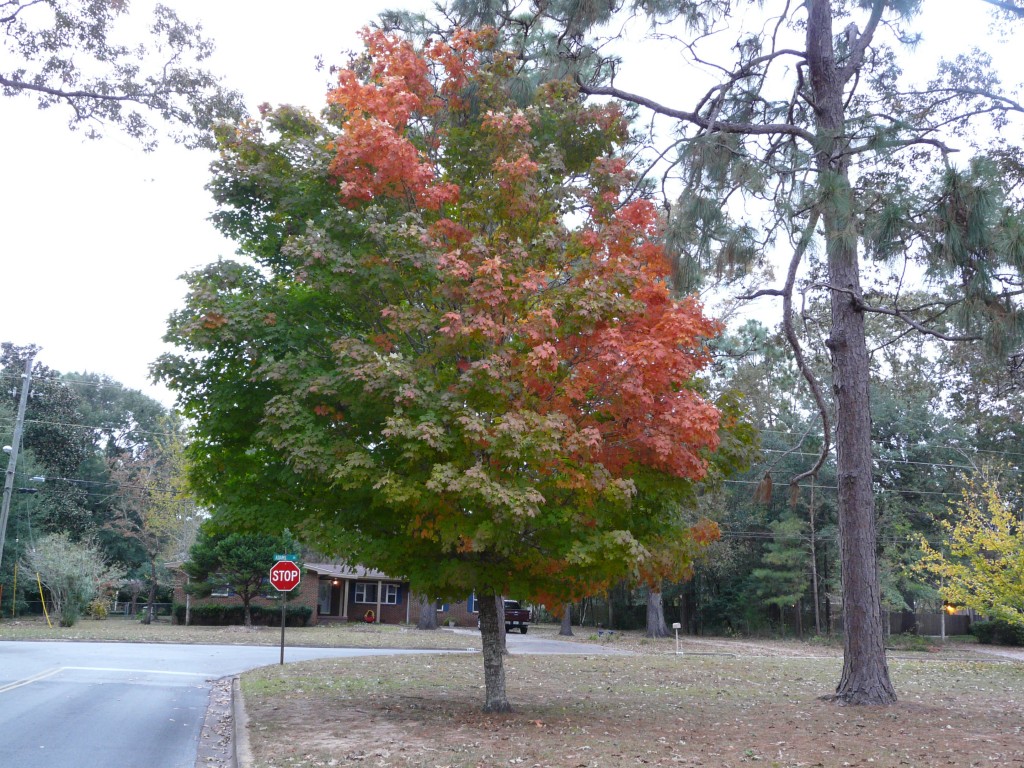
Florida maple beginning to exhibit fall color. Photo credit: Larry Williams, University of Florida/IFAS Extension – Okaloosa County
Tree Selection
Some trees grow faster than others. That’s not always a good thing, but if you’re trying to select a tree that grows fast and will provide shade in your yard then you might want to give the following species a try. Click on the links for more information.
A lot of times you’ll read a particular tree species prefers moist, well-drained soil. Some coastal soils are very well drained and require supplemental irrigation after establishment to keep some species alive. One tree that does well in sandy, well-drained soils without supplemental irrigation is the sand live oak. Another tree, that would never win a popularity contest, but does well in sandy soils is the sand pine. This tree has a gnarly growth habit, which would make it an interesting focal point in the landscape. Turkey oaks are another option for dry spots.
There are a lot of fruit tree species that can be grown successfully in the panhandle. The key to good fruit production is selecting trees that are adapted to the average number of chill hours (usually calculated by the number of hours between 34ºF and 45ºF) your yard receives on a yearly basis. Some peaches, plums, and nectarines have been developed for our climate. Citrus such as satsumas and tangerine hybrids grow well in the panhandle, but sometimes require cold protection. Persimmons, loquats, and pears are other fruit trees that grow well.
If you already have mature trees in your yard, then you may be looking for smaller, understory trees to enhance your landscape.
Living this far south, you often have to really seek out trees that change color in the fall. Dogwoods, Florida maples, and blackgum trees all have great fall color. Some of the red oaks also have nice fall color. Two that come to mind are the nuttall oak and the Shumard oak.
Trees can cause a lot of damage if planted too close to sidewalks or buildings. To determine if a tree will fit in a confined space, you will need to consider its mature trunk flare diameter.
Florida is the southern extreme for growing ginko trees. If you decide to plant a ginko tree, make sure to select a male cultivar to avoid stinky, slippery fruit.
To successfully plant a tree, you need to start with a healthy tree. If the tree you purchase was grown in a pot, make sure it isn’t rootbound and doesn’t have encircling roots. You also should inspect the tree’s form, branching structure, and look for the presence of included bark. Please read “Selecting Quality Trees from the Nursery” for more tips on what to look out for when purchasing a healthy tree.
Some trees are more tolerant than others of high winds and flooding. Please read this publication about tree failure from hurricanes to help determine what tree species are better adapted to these weather events.
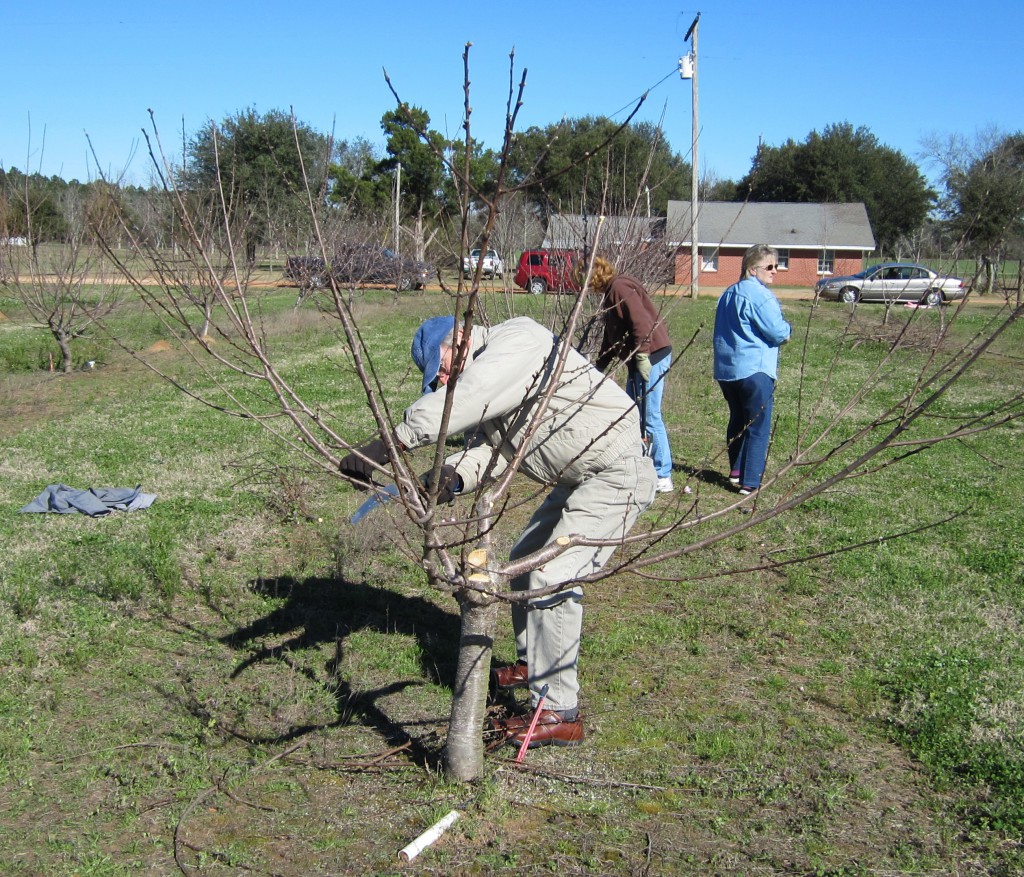
Santa Rosa County Master Gardener Pruning a Stone Fruit tree at the WFREC. Photo Credit: University of Florida/IFAS Extension
Tree Maintenance
Armillaria is a common fungal pathogen that infects trees from their roots. Other major diseases are more specific to certain species. A more comprehensive list of tree and shrub diseases can be found on the Ask IFAS website.
Tree establishment period depends on a lot of factors. Once a tree is established, it’s roots can be equal to about three times the distance from the trunk to the dripline.
Part of the beauty of a bald cypress is its knees. However they can also be a nuisance for mowing and other yard maintenance. The purpose of cypress knees is a bit of a mystery and there are a lot of theories on the subject.
Fallen leaves can help add nutrients back to your yard. Even if you are trying for a manicured lawn, you may want to rake up the leaves and use them elsewhere in the landscape.
Regardless of the species, most fruit trees benefit from a good pruning. Deciduous fruit trees should be pruned to maintain good branch structure and form, while citrus may benefit from a light hedging.
Trees are a wonderful addition to any landscape, but it’s important you select the right tree for the right place. Hopefully this article provided some information to guide you in the right direction.

by Sheila Dunning | Nov 4, 2021

Chewing caterpillar damage on St. Augustinegrass Photo by: Steven Arthurs, UF
Tropical sod webworm larvae are destructive pests of warm season turfgrasses in the southeastern U.S. especially in the fall. Commonly referred to as a worm, they are truly caterpillars, the larvae of a moth. Larval feeding damage reduces turfgrass aesthetics, vigor, photosynthesis and density, which is very evident on finer-bladed grasses such as bermudagrass and zoysiagrass. Feeding damage is possible on all grass types however. Adults, a dull brown colored moth about ¾ inch long, rest in sheltered and shrubby areas during the day and are active at dusk. Females deposit clusters of 10-35 eggs on the upper surface of grass blades. The eggs hatch in 3-4 days and develop from a 1 mm long caterpillar to one over 11 mm long through six instars within 21 to 47 days, depending on temperature. Larval feeding occurs at night, leaving the grass looking ragged, shortened and missing.

Sod webworm on soil surface
Photo by: Steven Arthurs, UF
Control should be against damaging larvae, not the flying moths. However, insecticidal soap applications to moth harboring areas can reduce re-population frequency. Soil-drenching soap flushes can be used to find the caterpillars, especially in dry and hot grass areas. Bacterial-based insecticides, such as Bt, Bacillus thuringiensis var. kurstaki or Spinosad, will control sod webworm caterpillars without impacting beneficial species as long as they are applied with each flush of grass growth.
Fall armyworms are also active when the weather turns cooler. They feed any time of the day or night, but are most active early in the morning or late in the evening. The 1 ½ inch long gray and white moth lays about 1,000 eggs in multiple masses on any vegetation. Two to 10 days later, the small caterpillar hatches and begins to grow to nearly 2 inches long over a two week period. The fall armyworm is easily recognized by its dark head marked with a distinct pale-colored inverted Y and the long black stripe running along each side of its body. These aggressive feeders “march” rapidly across grassed areas consuming every above-ground plant part. While bacterial-based insecticides will reduce the numbers, control of armyworms usually requires synthetic insecticides.

Armyworm
Photo by: Jim Castner, UF
The good news is that grass “worms” can be controlled and the blades will grow back. The damage may be devastating to see, but usually not a permanent problem.
















